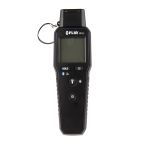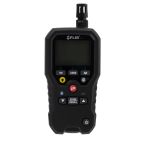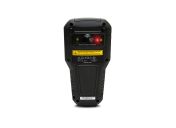FLIR Moisture Meters
A moisture meter, also known as a damp meter, is a device that measures the moisture content within a material such as plasterboard, wood, brick, and concrete. It is usually a probe or sensor that gets inserted into the material being tested. The reading on the meter then indicates the current percentage of moisture present. With FLIR moisture meters you can help improve air quality and ensure a healthy building.
Why do we need moisture meters?
Water and high humidity can cause significant damage, but early detection can deter water damage. FLIR moisture meters can help detect damp to prevent mould growth and structural damage, which can pose health risks. By accurately measuring moisture levels, FLIR meters ultimately help in:
- Ensuring drywall and concrete are properly cured and dried before further work, supporting structural integrity.
- Maximising efficiency in agriculture by determining storage conditions and optimal harvest times by measuring moisture within grains.
- Monitoring and preventing water damage in materials like wood, concrete, and more.
- Quality control in industries like agriculture and woodworking.
- Maximise safety and reduce health risks caused my mould growth.
What is the difference between a pin type and pin-less type moisture meter?
Both pin-type and pinless-type moisture meter are handheld and have a screen to display the readings. Moisture meters can be available in both a digital form with a backlit LCD display or in an analogue form with a needle scale. Although similar, the meters work in slightly different ways, so it is important to select the appropriate one dependent on the intended applications.
Pin-type moisture meters are great when you need higher accuracy and localised measurements at specific points on a material. When working with materials that are easily penetrable, pin-type meters can do the job. Applications such as woodworking or construction, pin-type moisture meters are useful for assessing the moisture content.
Pinless-type moisture meters, however, are commonly opted for when non-destructive testing is required, such as finished wood surfaces, carpeted floors, or painted walls. These meters are also quicker when screening for large-scale applications, where it can provide an average reading of a larger area without damaging the material. So if you are working with thicker materials, like concrete slabs, or need surface measurements, then pinless moisture meters are a great option.
Applications
Moisture meters can be used across a range of industries. Some common industries and applications that FLIR moisture meters can be used in include:
- Flooring installation
- Property and construction
- Building inspections
- Furniture makers and woodworking
- Environmental monitoring
- Food processing
- Paper and textile industry
- Agriculture
- Fire and flood restoration
5 Products showing for FLIR Moisture Meters
Popular Searches
Related links
- A Complete Guide to Moisture Meters
- Protimeter BLD3050 Moisture Meter AC Adapter-Powered
- Protimeter BLD5770 Moisture Meter AC Adapter-Powered
- Protimeter BLD5375 Moisture Meter LED Display, AC Adapter-Powered
- Protimeter BLD5609 Moisture Meter LCD Display, Battery-Powered
- Protimeter BLD9800 Moisture Meter LCD Display, Battery-Powered
- Extech Moisture Meter Pin for Use with Select Extech Moisture Meters
- FLIR Moisture Meter Pin for Use with Moisture Meters




